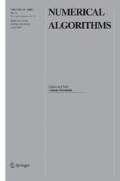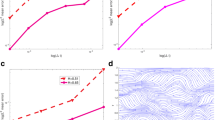Abstract
In this paper, we study the numerical schemes for the two-dimensional Fokker-Planck equation governing the probability density function of the tempered fractional Brownian motion. The main challenges of the numerical schemes come from the singularity in the time direction. When 0 < H < 0.5, a change of variables \(\partial \left (t^{2H}\right )=2Ht^{2H-1}\partial t\) avoids the singularity of numerical computation at t = 0, which naturally results in nonuniform time discretization and greatly improves the computational efficiency. For H > 0.5, the time span dependent numerical scheme and nonuniform time discretization are introduced to ensure the effectiveness of the calculation and the computational efficiency. The stability and convergence of the numerical schemes are demonstrated by using Fourier method. By numerically solving the corresponding Fokker-Planck equation, we obtain the mean squared displacement of stochastic processes, which conforms to the characteristics of the tempered fractional Brownian motion.



Similar content being viewed by others
References
Metzler, R., Klafter, J.: The random walk’s guide to anomalous diffusion: a fractional dynamics approach. Phys. Rep. 339(1), 1–77 (2000)
Bruno, R., Sorriso-Valvo, L., Carbone, V., Bavassano, B.: A possible truncated-Lévy-flight statistics recovered from interplanetary solar-wind velocity and magnetic-field fluctuations. Europhys. Lett. 66(1), 146–152 (2004)
Chen, Y., Wang, X.D., Deng, W.H.: Localization and ballistic diffusion for the tempered fractional Brownian-Langevin motion. J. Stat. Phys. 169(1), 18–37 (2017)
Deng, W.H., Zhang, Z.J.: High Accuracy Algorithm for the Differential Equations Governing Anomalous Diffusion. World Scientific, Singapore (2019)
Deng, W.H., Li, B.Y., Tian, W.Y., Zhang, P.W.: Algorithm implementation and numerical analysis for the two-dimensional tempered fractional Laplacian. Multiscale Model Simul. 16(1), 125–149 (2018)
Deng, W.H., Wu, X.C., Wang, W.L.: Mean exit time and escape probability for the anomalous processes with the tempered power-law waiting times. EPL. 117 (1), 10009 (2017)
Drysdale, P.M., Robinson, P.A.: Lévy random walks in finite systems. Phys. Rev. E. 58(5), 5382–5394 (1998)
Metzler, R., Klafter, J.: The restaurant at the end of the random walk: recent developments in the description of anomalous transport by fractional dynamics. J. Phys. A. 37(31), R161–R208 (2004)
Schumer, R., Meerschaert, M.M., Baeumer, B.: Fractional advection-dispersion equations for modeling transport at the Earth surface. J. Geophys. Res. 114(6), F00A07 (2009)
Chen, Y., Wang, X.D., Deng, W.H.: Tempered fractional Langevin-Brownian motion with inverse β-stable subordinator. J. Phys. A: Math. Theor. 51(49), 495001 (2018)
Meerschaert, M.M., Sabzikar, F.: Tempered fractional Brownian motion. Stat. Probab. Lett. 83(10), 2269–2275 (2013)
Meerschaert, M.M., Sabzikar, F.: Stochastic integration for tempered fractional Brownian motion. Stoch. Process. Appl. 124(7), 2363–2387 (2014)
Yuste, S.B., Quintana-Murillo, J.: A finite difference method with non-uniform timesteps for fractional diffusion equations. Comput. Phys. Comm. 183 (12), 2594–2600 (2012)
Filbet, F., Pareschi, L.: A numerical method for the accurate solution of the Fokker-Planck-Landau equation in the nonhomogeneous case. J. Comput. Phys. 179 (1), 1–26 (2002)
Zhang, Y.N., Sun, Z.Z.: Alternating direction implicit schemes for the two-dimensional fractional sub-diffusion equation. J. Comput. Phys. 230(24), 8713–8728 (2011)
Jin, S., Yan, B.: A class of asymptotic-preserving schemes for the Fokker-Planck-Landau equation. J. Comput. Phys. 230(17), 6420–6437 (2011)
Zhuang, P., Liu, F.: Implicit difference approximation for the time fractional diffusion equation. J. Appl. Math. Comput. 22(3), 87–99 (2006)
Chen, C.M., Liu, F., Turner, I., Anh, V.: Numerical schemes and multivariate extrapolation of a two-dimensional anomalous sub-diffusion equation. Numer. Algor. 54(1), 1–21 (2010)
Smith, J.: Engineering applications of ADI methods to piecewise linear multidimensional heat transfer. J. Comput. Phys. 17(2), 181–191 (1975)
Epperlein, E.M.: Implicit and conservative difference scheme for the Fokker-Planck equation. J. Comput. Phys. 112(2), 291–297 (1994)
Reichmann, O.: Optimal space-time adaptive wavelet methods for degenerate parabolic PDEs. Numer. Math. 121(2), 337–365 (2012)
Zhuang, P., Liu, F., Anh, V., Turner, I.: New solution and analytical techniques of the implicit numerical method for the anomalous subdiffusion equation. SIAM J. Numer. Anal. 46(2), 1079–1095 (2008)
Napolitano, M.: Efficient ADI and spline ADI methods for the steady-state Navier-Stokes equations. Int. J. Numer. Meth. Fluids. 4(12), 1101–1115 (1984)
Yuste, S.B., Acedo, L.: An explicit finite difference method and a new von neumann-type stability analysis for fractional diffusion equations. SIAM J. Numer. Anal. 42(5), 1862–1874 (2005)
Lemou, M., Mieussens, L.: Implicit schemes for the Fokker–Planck–Landau equation. SIAM J. Numer. Anal. 27(3), 809–830 (2005)
Zhang, Y.N., Sun, Z.Z.: Error analysis of a compact ADI scheme for the 2D fractional subdiffusion equation. J. Sci. Comput. 59(1), 104–128 (2014)
Shen, S., Liu, F.: Error analysis of an explicit finite difference approximation for the space fractional diffusion equation with insulated ends. ANZIAM J. 46(E), 871–887 (2005)
Murio, D.A.: Implicit finite difference approximation for time fractional diffusion equations. Comput. Math. Appl. 56(4), 1138–1145 (2008)
Langlands, T.A.M., Henry, B.I.: The accuracy and stability of an implicit solution method for the fractional diffusion equation. J. Comput. Phys. 205(2), 719–736 (2005)
Funding
This work was financially supported by the National Natural Science Foundation of China under Grant No. 11671182, and the Fundamental Research Funds for the Central Universities under Grants No. lzujbky-2018-ot03.
Author information
Authors and Affiliations
Corresponding author
Additional information
Publisher’s note
Springer Nature remains neutral with regard to jurisdictional claims in published maps and institutional affiliations.
Appendices
Appendix A: Numerical stability
For 0 < H < 0.5, the Fourier series of uk(x,y) is
where
There exists Parseval equation
From (2.4), we get
Substituting (A.1) into (A.2) leads to
where
Since the two sides of (A.3) are the Fourier series, we have
where
This implies that
Combining Parseval equation and (A.4) results in
As H > 0.5, for \(t\ge t_{\max \nolimits }=t_{k_{1}}\), using the same process, we have
where
and
For k ≤ k1, with the proof being completely the same as the case that 0 < H < 0.5, there exists
For k > k1, combining (A.5) and (A.6) leads to
Appendix B: Convergence
We use notations
As 0 < H < 0.5, performing the Taylor expansion at \(t_{k}^{2H}\), there exist
and
Letting \( R_{m,n}^{k}=L^{(1)}u_{m,n}^{k}-[Lu(x,y,t)]_{m,n}^{k}, \) and using (B.1) and (B.2) lead to
For \(e_{m,n}^{k}=u_{m,n}^{k}-u(x_{m},y_{n},t_{k})\), from (1.3), (2.4), and (B.3), we have
Following the proof process of numerical stability and using the expansion similar to (A.3), there exists
leading to
For H > 0.5, when \(t>t_{\max \nolimits }\), by Taylor expansion at \({t_{k}^{H}}\), we have
and
which implies that
For k ≤ k1,
When k ≥ k1, combining (B.6) leads to
Rights and permissions
About this article
Cite this article
Liu, X., Deng, W. Numerical methods for the two-dimensional Fokker-Planck equation governing the probability density function of the tempered fractional Brownian motion. Numer Algor 85, 23–38 (2020). https://doi.org/10.1007/s11075-019-00800-z
Received:
Accepted:
Published:
Issue Date:
DOI: https://doi.org/10.1007/s11075-019-00800-z



